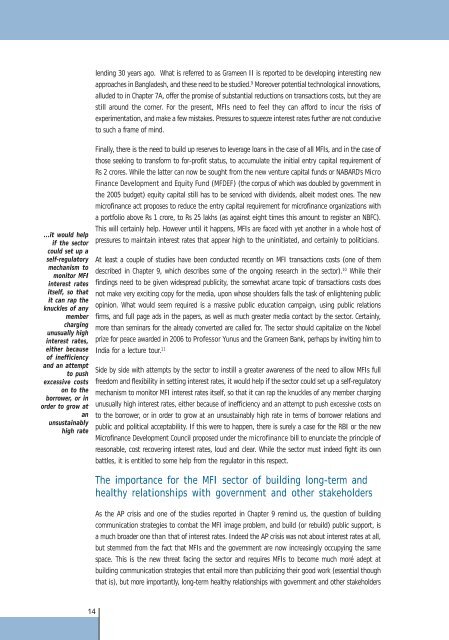Download sector_report1.pdf - Microfinance and Development ...
Download sector_report1.pdf - Microfinance and Development ...
Download sector_report1.pdf - Microfinance and Development ...
You also want an ePaper? Increase the reach of your titles
YUMPU automatically turns print PDFs into web optimized ePapers that Google loves.
lending 30 years ago. What is referred to as Grameen II is reported to be developing interesting new<br />
approaches in Bangladesh, <strong>and</strong> these need to be studied. 9 Moreover potential technological innovations,<br />
alluded to in Chapter 7A, offer the promise of substantial reductions on transactions costs, but they are<br />
still around the corner. For the present, MFIs need to feel they can afford to incur the risks of<br />
experimentation, <strong>and</strong> make a few mistakes. Pressures to squeeze interest rates further are not conducive<br />
to such a frame of mind.<br />
...it would help<br />
if the <strong>sector</strong><br />
could set up a<br />
self-regulatory<br />
mechanism to<br />
monitor MFI<br />
interest rates<br />
itself, so that<br />
it can rap the<br />
knuckles of any<br />
member<br />
charging<br />
unusually high<br />
interest rates,<br />
either because<br />
of inefficiency<br />
<strong>and</strong> an attempt<br />
to push<br />
excessive costs<br />
on to the<br />
borrower, or in<br />
order to grow at<br />
an<br />
unsustainably<br />
high rate<br />
Finally, there is the need to build up reserves to leverage loans in the case of all MFIs, <strong>and</strong> in the case of<br />
those seeking to transform to for-profit status, to accumulate the initial entry capital requirement of<br />
Rs 2 crores. While the latter can now be sought from the new venture capital funds or NABARD's Micro<br />
Finance <strong>Development</strong> <strong>and</strong> Equity Fund (MFDEF) (the corpus of which was doubled by government in<br />
the 2005 budget) equity capital still has to be serviced with dividends, albeit modest ones. The new<br />
microfinance act proposes to reduce the entry capital requirement for microfinance organizations with<br />
a portfolio above Rs 1 crore, to Rs 25 lakhs (as against eight times this amount to register an NBFC).<br />
This will certainly help. However until it happens, MFIs are faced with yet another in a whole host of<br />
pressures to maintain interest rates that appear high to the uninitiated, <strong>and</strong> certainly to politicians.<br />
At least a couple of studies have been conducted recently on MFI transactions costs (one of them<br />
described in Chapter 9, which describes some of the ongoing research in the <strong>sector</strong>). 10 While their<br />
findings need to be given widespread publicity, the somewhat arcane topic of transactions costs does<br />
not make very exciting copy for the media, upon whose shoulders falls the task of enlightening public<br />
opinion. What would seem required is a massive public education campaign, using public relations<br />
firms, <strong>and</strong> full page ads in the papers, as well as much greater media contact by the <strong>sector</strong>. Certainly,<br />
more than seminars for the already converted are called for. The <strong>sector</strong> should capitalize on the Nobel<br />
prize for peace awarded in 2006 to Professor Yunus <strong>and</strong> the Grameen Bank, perhaps by inviting him to<br />
India for a lecture tour. 11<br />
Side by side with attempts by the <strong>sector</strong> to instill a greater awareness of the need to allow MFIs full<br />
freedom <strong>and</strong> flexibility in setting interest rates, it would help if the <strong>sector</strong> could set up a self-regulatory<br />
mechanism to monitor MFI interest rates itself, so that it can rap the knuckles of any member charging<br />
unusually high interest rates, either because of inefficiency <strong>and</strong> an attempt to push excessive costs on<br />
to the borrower, or in order to grow at an unsustainably high rate in terms of borrower relations <strong>and</strong><br />
public <strong>and</strong> political acceptability. If this were to happen, there is surely a case for the RBI or the new<br />
<strong>Microfinance</strong> <strong>Development</strong> Council proposed under the microfinance bill to enunciate the principle of<br />
reasonable, cost recovering interest rates, loud <strong>and</strong> clear. While the <strong>sector</strong> must indeed fight its own<br />
battles, it is entitled to some help from the regulator in this respect.<br />
The importance for the MFI <strong>sector</strong> of building long-term <strong>and</strong><br />
healthy relationships with government <strong>and</strong> other stakeholders<br />
As the AP crisis <strong>and</strong> one of the studies reported in Chapter 9 remind us, the question of building<br />
communication strategies to combat the MFI image problem, <strong>and</strong> build (or rebuild) public support, is<br />
a much broader one than that of interest rates. Indeed the AP crisis was not about interest rates at all,<br />
but stemmed from the fact that MFIs <strong>and</strong> the government are now increasingly occupying the same<br />
space. This is the new threat facing the <strong>sector</strong> <strong>and</strong> requires MFIs to become much moré adept at<br />
building communication strategies that entail more than publicizing their good work (essential though<br />
that is), but more importantly, long-term healthy relationships with government <strong>and</strong> other stakeholders<br />
14














